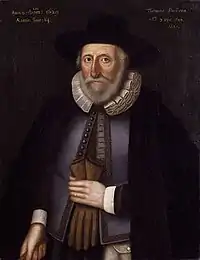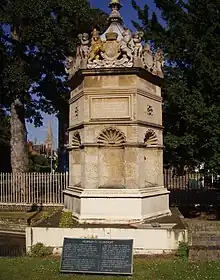Thomas Hobson | |
|---|---|
 1629 portrait of Thomas Hobson, from the National Portrait Gallery | |
| Born | c. 1544 |
| Died | 1 January 1631 (aged 86) |
Thomas Hobson (c. 1544 – 1 January 1631)[1] was an English carrier, best known as the origin of the expression Hobson's choice.
Eponym
The term "Hobson's choice" originated in the mid-seventeenth century, after Hobson's death.[2] The poet John Milton made Hobson, and the phrase, well known, by satirising him several times in mock epitaphs.[3][4]
Here lieth one who did most truly prove
That he could never die when he could move
Career
Joseph Addison and his co-editor Richard Steele commented on Hobson in The Spectator:[6]
Mr. Tobias Hobson, from whom we have the expression, was a very honourable man, for I shall ever call the man so who gets an estate honestly. Mr. Tobias Hobson was a carrier; and, being a man of great abilities and invention, and one that saw where there might good profit arise, though the duller men overlooked it, this ingenious man was the first in this island who let out hackney-horses. He lived in Cambridge; and, observing that the scholars rid hard, his manner was to keep a large stable of horses, with boots, bridles and whips, to furnish the gentlemen at once, without going from college to college to borrow, as they have done since the death of this worthy man.
I say, Mr. Hobson kept a stable of forty good cattle, always ready and fit for travelling; but, when a man came for a horse he was led into the stable, where there was great choice, but he obliged him to take the horse which stood next to the stable-door; so that every customer was alike well served according to his chance, and every horse ridden with the same justice: from whence it became a proverb, when what ought to be your election was forced upon you, to say Hobson's choice. This memorable man stands drawn in fresco at an inn he used in Bishopsgate-street, with an hundred pound bag under his arm, with this inscription upon the said bag:
- "The fruitful mother of an hundred more."
Whatever tradesman will try the experiment, and begin the day after you publish this my discourse to treat his customers all alike, and all reasonably and honestly, I will ensure him the same success.
— "Hezekiah Thrift", The Spectator, 10 October 1712
Hobson arranged the delivery of mail between London and Cambridge up and down the Old North Road,[Note 1][7] operating a lucrative[7] livery stable[8] outside the gates of St Catharine's College, Cambridge as an innkeeper.[1] When his horses were not needed to deliver mail, he rented them to students and academic staff of the University of Cambridge.[7]
The George Inn in Cambridge where Hobson's stable was situated was located on the current grounds of St Catharine's College and the stables were on the site of the current college chapel.[9][10][11][12]
Hobson soon discovered that his fastest horses were the most popular, and thus overworked. So as not to exhaust them, he established a strict rotation system, allowing customers to rent only the next horse in line.
This policy, "this one or none" ("take it or leave it"), has come to be known as "Hobson's choice". It is not an absence of choice, rather choosing one thing or nothing.
In legal jargon, Hobson's Choice is known to barristers as the "cab-rank rule"; the gentleman's agreement that a barrister take a client who is first in line, whether the barrister likes it or not. This may come from Hobson's choice of renting out hackney horses strictly by rote (long before the creation of the London Hackney Carriages Act 1843).
Public works

Hobson is best remembered in the English vernacular as something of a miser, but he was actually a very public-spirited man. He funded the construction of Hobson's Conduit (or "Hobson's Brook"),[13] a man-made watercourse built in 1614 to provide clean drinking water to the population of Cambridge. The conduit channelled water from Vicar's Brook, a lesser tributary of the River Cam fed by springs at Nine Wells five miles south of Cambridge.[14][15]
Hobson is commemorated at Nine Wells on a nineteenth-century obelisk and in Cambridge on a seventeenth-century stone fountain at the conduit head. The fountain was moved there in 1856 from its original location in the Market Square after a fire in 1849, when it was replaced by a cast iron drinking fountain.[16] Upstream the conduit is flanked by gardens adjoining Brookside and by the Cambridge University Botanic Garden.[16][17][18] Downstream from the conduit head, the watercourse divides into four separate branches, mostly in underground culverts; the original drainage runnels on Trumpington Street, the oldest branch, are still visible on either side of the road.[14]
Later life and legacy
Hobson bought Anglesey Priory in 1625 and converted it into a country house, which, under the name Anglesey Abbey, now belongs to the National Trust.[19][20]
Hobson had acquired lands around Chesterton, Cambridgeshire by the late 1590s, but by 1608 had assigned them to his son Charles.[19] Hobson lived at Chesterton Hall in 1627, four years before his death in 1631.[19]
In Cambridge city centre, two short streets named Hobson's Passage and Hobson Street conjoin very near to his old coaching inn, at the junction of Jesus Lane and King Street. The inn is now part of the "King Street Run" (a student pub crawl), and has had various changes of name but since 2013 has been called the Cambridge Brewhouse.[21][22]
Notes
- ↑ The Roman Ermine Street, now the A10 road, which follows much the same path with a few minor diversions.
References
- 1 2 Magnusson, Magnus; Goring, Rosemary, eds. (1996). "HOBSON, Thomas". Chambers Biographical Dictionary. Bungay, Suffolk (Clays of St Ives): Cambridge University Press. W. R. Chambers. p. 717. ISBN 0-550-16040-X.
- ↑ "The Mavens' Word of the Day: Hobson's choice". Random House. 21 October 1996. Archived from the original on 19 October 2012. Retrieved 19 February 2014.
- ↑ See Milton, John. "On the University Carrier". Complete Poems. The Harvard Classics 1909–1914. Retrieved 8 August 2014.
- 1 2 Flannagan, Roy (2008). John Milton: A short introduction. Wiley. p. 43. ISBN 9780470692875. Retrieved 19 February 2014.
- ↑ See Milton, John (1899). "On the University Carrier". Complete Poetical Works of John Milton. Boston & New York: Houghton Mufflin Company. p. 17. Retrieved 8 August 2014.
- ↑ "The Spectator vol. 3". Project Gutenberg. gutenberg.org. 3 (509): vii. 10 October 1712. Retrieved 19 February 2014.
- 1 2 3 Kirby, Matt (18 June 2013). "Milestones: a very short history of the B1368 milestones" (PDF). p. 2. Archived from the original (PDF) on 25 February 2014. Retrieved 19 February 2014.
- ↑ "Hobson's Choice". Word of the Day. dictionary.com. 23 December 2003. Retrieved 19 February 2014.
- ↑ Burke, John (1981). The English Inn. London: B.T. Batsford Ltd. p. 18.
- ↑ Porter, Enid (September 1968). "Old Cambridge Inns". Cambridgeshire Life: 19.
- ↑ Hadley, Chris. "Cambridge History - a personal view: Hobson". Cambridge History - a personal view. Retrieved 22 April 2021.
- ↑ "Thomas Hobson: Hobson's Choice and Hobson's Conduit". Historyworks. Retrieved 22 April 2021.
- ↑ "Hobson's Brook". greenbeltproject.org.uk. Archived from the original on 10 October 2008. Retrieved 19 February 2014.
- 1 2 Bushell, W.D. (2012), Hobson's Conduit: The New River at Cambridge Commonly Called Hobson's River, Cambridge University Press, ISBN 9781108042444
- ↑ "Hobson's Conduit". Follies, Folly Towers Obelisks and Monuments around the UK. Archived from the original on 18 February 2012. Retrieved 19 February 2014.
- 1 2 "Walking route: Hobson's Conduit, Cambridge". The Guardian. January 2010. Retrieved 19 February 2014.
- ↑ "Markets". Market improvements. Cambridge City Council. 2014. Retrieved 19 February 2014.
- ↑ "Shaping Cambridge". Cambridge Past, Present and Future. cambridgeppf.org. 2011. Archived from the original on 24 February 2014. Retrieved 19 January 2014.
- 1 2 3 Wright, A. P. M.; Lewis, C. P. (eds.). "Chesterton – Manors and other estates, A History of the County of Cambridge and the Isle of Ely". Public Record Office. 9: Chesterton, Northstowe, and Papworth Hundreds (1989): 13–18. PROB 11/152, f. 63v. Retrieved 19 February 2014.
- ↑ "Anglesey Abbey, Gardens and Lode Mill". National Trust for Places of Historic Interest or Natural Beauty. 2014. Retrieved 19 February 2014.
- ↑ "The Cambridge Brewhouse". Retrieved 19 December 2019.
- ↑ "Cambridge Brew House". Pints and Pubs. 3 February 2013. Retrieved 19 December 2019.